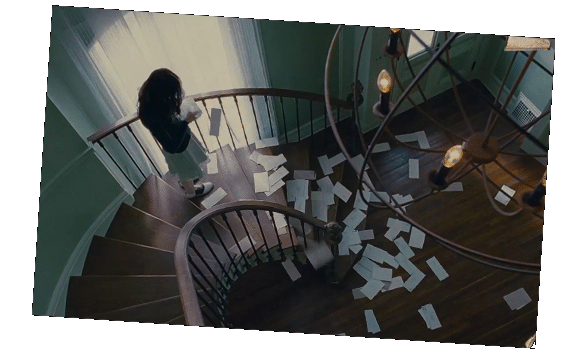 |
| Move poster for Stoker |
Written by Amanda Rodriguez
Spoiler Alert
The first time you watch Stoker, it’s something of a perplexing experience because the narrative is such a genre-bender. I spent at least half the movie wondering what kind of movie I was watching. Not to toot my own horn overly much, but I’ve got a bit of an eye for formulas and am pretty good at spotting them. A film that can keep me on my toes like Stoker did is a rare, commendable animal. The direction Stoker did end up taking was also surprising, unique, and oddly feminist.
Ultimately, Stoker is the coming-of-age tale of a blossoming female serial killer. A “true” female serial killer is not only rare in cinema, but in real life as well. You’re probably thinking, “What the hell is she talking about? There are a slew of female serial killer movies and real-life figures I can think of off the top of my head.” In truth, women serial murderers kill for reasons different from their male counterparts. Typically, women kill for money or revenge, targeting people they know or to whom they’re related. Whereas male serial killers tend to predominantly kill strangers with the motivation being sexual in natural. To clarify, male serial killer motivation surrounds power and usually displays itself in sexualized killings or in the sexual response the killer has to his murders. Not only that, but some of the world’s most famous female serial killers work in partnership with a male serial killer, thus simulating that psychosexuality inherent in their murders.
India Stoker (portrayed by the amazingly talented Mia Wasikowska) meets her creepy serial killer uncle Charlie (Matthew Goode), and the more strangely he behaves and the more evidence India has of his murderousness, the more attracted she is to him.
 |
| Finds housekeeper’s dead body in the basement freezer. Starts hanging out with Charlie more. |
Their unsettling, incestuous flirtation culminates in their joint murder of India’s classmate, Whip. The boy and India make out in the woods, and when she decides she’s had enough of him, the boy tries to rape her. Charlie swoops in to rescue her, and, together, the two kill India’s assailant. The movie makes it clear that Whip is an utter piece of shit and totally has it coming, so there’s little moral ambiguity in this kill, which differentiates it from Charlie’s prior murders (the housekeeper, an aunt, and, at this point, we suspect India’s father). India’s actions of self-defense and the shittiness of the victim leave the lingering possibility that India is not, in fact, serial killer material.
The following scene is the classic post sexual assault shower scene with a twist. We see India hunched over and whimpering in the shower intercut with flashbacks to the assault and Whip’s death. It gradually dawns on the audience that India isn’t weeping, she’s masturbating. This scene is pivotal and is, in fact, one of the major climaxes of the film, which makes the structure of the film itself more feminist. Feminists have noted for many years that the typical story structure with the single climax near the end of the film followed by the denouement more closely resembles the pattern of male sexual pleasure. A more feminist structure would allow for multiple climactic scenes, which Stoker does. (There are more climactic moments nearer the end of the film, which I’ll get into shortly.) Not only is the film’s first climax a scene that ends with a woman actually orgasming, it is a masturbation scene wherein India is pleasuring herself.
 |
| That’s a boat-load of female agency right there. |
India comes to realize in yet another climactic, pivotal scene that Charlie is mentally ill (perhaps even more than she is herself), that he wants to take her away with him, and that he has always wanted to be with her. Not only that, but the film reveals to the audience what India strongly suspects: Charlie murdered India’s father in order to be with her.
Despite her realization that Charlie is insane, India agrees to leave with him because his presence and guidance have triggered her coming-of-age and shown her that she isn’t alone in her proclivities. It turns out, though, that a prerequisite for running away with Charlie is allowing him to kill off her mother, Evelyn (Nicole Kidman). Because India and Evelyn have a difficult relationship in which they don’t relate to one another with no love lost between them, Charlie supposes this is an easy enough task to get out of the way before spiriting his beloved India away. While he brutally strangles Evelyn with his belt, India calmly puts her rifle together, aims her sights (at who? Evelyn or Charlie?), and fires.
Let’s take a quick second to examine Charlie and India’s choice of weaponry. Charlie favors a belt, stolen from his brother/India’s father, with which he strangles his victims to death. India, we learn, favors her hunting rifle. Not choosing the tool of her mentor differentiates her from him, allowing her an identity unique to him despite their overwhelming similarities. Not only that, but you could get all psychoanalytic on this shit and view their weapon choices as a form of gender role reversal. Charlie’s belt, which encircles and constricts could be viewed as vaginal, while India’s gun with its shape and its firing of bullets is a common phallic symbol. Within our world that views masculinity and masculine symbols as superior, India’s weapon of choice subtly establishes her dominance over Charlie, a fact that is further reinforced when she kills him.
In spite of the sexual connection India has with Charlie, in spite of their shared interests and secrets, in spite of the estranged relationship she has with her mother, India chooses to save Evelyn and nonchalantly shoots and kills her uncle. I admit I was worried for a minute because it’s not a very strong feminist statement when a young girl must essentially murder her mother in order to come into adulthood and into her sexual identity, even if we’re talking about a budding serial killer. India, unlike her mother, does not choose a man fresh on the scene over the woman with whom she’s been sharing a home and life for 18 years. Neither, though, does India stick around to live out the rest of her life trapped in a mother-daughter dynamic wherein neither one of them is capable of loving the other. Instead, she takes off in her new black pumps wearing her father/Charlie’s belt with her rifle and her uncle’s flashy convertible. If it’s unclear which path she’s chosen, we have a final climactic moment in which India shoots the sheriff (har, har) who pulls her over for speeding.
 |
| India with the rifle |
The more I think about this movie, the more I like it, and the more feminist tropes I see in it. The Freudian parallels, genre subversion, and feminist subtext (or just regular text?) didn’t happen by accident; director Chan-wook Park is meticulously deliberate about his imagery, symbolism, and delivery of dialogue. The strict, generally accepted, masculine definition I gave above for what constitutes a serial killer is, in itself, a gender-biased, sexist definition that gives legitimacy and near rockstar status to men who murder multiple people (predominantly women) in order to feel a sexualized rush of power. By this definition, serial killers are an elite boys club of He-Man Woman Haters who don’t allow female participation. Trying to make a woman fit into this masculine mold is a dubious honor, but I can’t help but appreciate the deft skill with which Park makes this a believable possibility. Not only is India a multifaceted character, but she is strong, smart, independent, and finds her own path while creating her own moral code outside the patriarchal strictures that Charlie attempts to impose upon her. India may transition from heroine to anti-heroine throughout the course of Stoker, and she may be a scary-ass serial killer, but she is, nonetheless, a powerful, feminist figure.


so in order to be a powerful, feminine heroine you must prove you can independently enter the “boys’ club” of serial killers without the help of a man? I found this movie a disgusting indie-hipster version of Mr. Brooks…with better camera angles and color arrangements. Glorifying serial killing is absurd, regardless of sex.
When so much of the serial killer genre is defined by masculinity and male power, subverting it is a feminist action. No one’s calling India Stoker a role model or a feminist leader, but in a genre where women usually have their power taken away, it’s a pleasure to see a woman take it for herself.
Hi! I really enjoyed this interpretation, thanks! I have some of my own ideas as well – if ever you were curious (fully compatible too). One small thing I thought could be added is that India has in mind to kill Charlie instead of Evelyn as soon as she knows Charlie killed her father. She slaps him, remains eerily cold when he gives her her “adult woman” shoes, and sees the hunting scene where her father tells her to wait for the right time to kill. I think that is the truest moment of adulthood, when she fully defines her own identity: not simply associated with what is similar or rejecting what is different (whether in Charlie, her father, her mother, or her peers). She has picked and chosen who she is with elements of each influence of her life. The fact that she then kills Charlie right when he is about to kill her mother shows how strong and independent she is indeed: not dependent on others like her mother chose to be, and not pining after childish oneness like Charlie…
Female serial killers are no so rare. Look at “Index: Female Serial Killers” on Google. It has hundreds out of 859 cases collected so far. “Creepiest Female Serial Killers” is a good introduction to the topic. The current study of female serial killers is the absolute cutting edge of Women’s Studies.